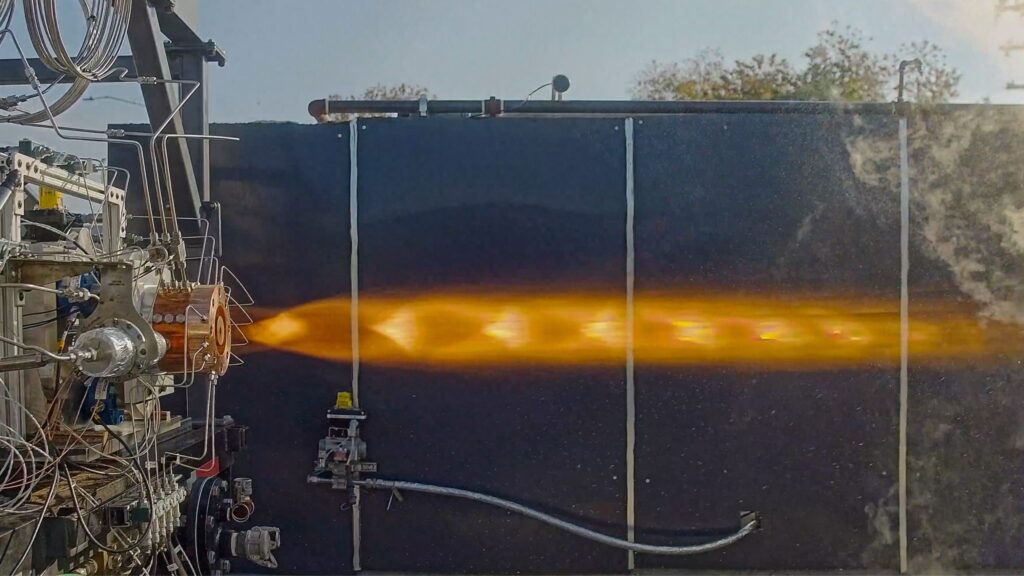Venus Aerospace has successfully completed NASA-supported testing of advanced nozzle designs for its compact Rotating Detonation Rocket Engine (RDRE), a breakthrough in hypersonic propulsion. Backed by a Small Business Innovation Research (SBIR) award, the tested nozzles exceeded expectations and will be integrated into a flight demonstration this summer. Venus’s RDRE uses supersonic shockwaves to generate greater thrust with less fuel, offering a scalable and efficient alternative to traditional engines. The company’s single-engine system enables takeoff, hypersonic cruise, and jet-like efficiency, with applications ranging from spacecraft and satellites to hypersonic drones and missiles. Read the full press release:
Venus Aerospace, the startup building the world’s most advanced engine system for hypersonic flight, today announced the successful completion of a NASA-supported technological advancement—one that will outfit Venus’s record-setting hypersonic engine system during an upcoming flight demonstration later this summer.
Through a Small Business Innovation Research (SBIR) award, NASA supports high-potential companies building the future of aerospace technology. Venus used NASA’s award to test new nozzle designs—the part of the engine that shapes and directs power—for its unique, compact rocket engine. The top-performing design exceeded expectations and will be integrated into Venus’s ground-based launch test in the coming months.
“We’ve already proven our engine outperforms traditional systems on both efficiency and size,” said CEO Sassie Duggleby. “The technology we developed with NASA’s support will now be part of our integrated engine platform—bringing us one step closer to proving that efficient, compact, and affordable hypersonic flight can be scaled.”
The engine at the center of Venus’s flight platform is a Rotating Detonation Rocket Engine (RDRE)—a system long considered promising but never proven at scale. Venus is the first U.S. company to make a scalable, affordable RDRE flight-ready. Unlike conventional rocket engines, the Venus RDRE operates through supersonic shockwaves—called detonations—that generate more power with less fuel.
“This is just the beginning of what can be achieved with Venus propulsion technology,” said Andrew Duggleby, Venus Aerospace CTO. “We’ve built a compact, high-performance system that unlocks speed, range, and agility across aerospace, defense, and many other applications. And we’re confident in its readiness for flight.”
This summer’s flight will mark a significant milestone in demonstrating efficient, affordable, detonation-based propulsion at scale. Combined with Venus’s in-house IP and performance breakthroughs—including previously demonstrated efficiency in the upper 90th percentile compared to standard rocket engines—the integrated system is now one of the most advanced of its kind. And it’s just the beginning, with more innovations on the horizon.
One Engine System. All Speeds.
This development builds on a series of advances at Venus Aerospace. Last fall, the company unveiled a high-speed engine system that enables takeoff, acceleration, and hypersonic cruise—all powered by a single engine architecture. While most high-speed systems require multiple engines to operate at different speeds, Venus’s approach eliminates the cost, weight, and complexity of traditional propulsion technology.
The system delivers rocket-like takeoff power and jet-like cruise efficiency—all in a remarkably compact form. Its elegant simplicity unlocks major advantages in speed, range, reusability, and cost—enabling a vehicle to accelerate from runway to Mach 5+ without changing engines.
The Venus system supports a wide range of applications, including:
- Spacecraft landers
- Low Earth orbit satellites
- Space cargo transfer vehicles
- Rocket kick-stages
- Hypersonic drones and missiles
Read more here.





